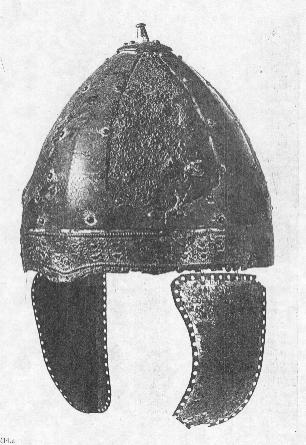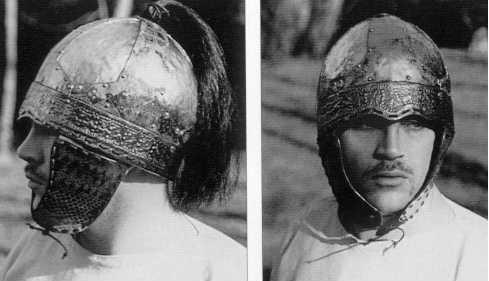|
Making a helmet of this type is not for a beginner but you don't need to be
a professional either. It can be made using simple hand tools, in the way the
original was made.
The Batajnica spangenhelm was made from:
- 4 T-shaped spangen (copper/bronze) with punch work decoration
- An apex disk (copper/bronze) with punch work decoration
- An apex knob (copper/bronze)
- 4 iron plates
- 4 rectangular rivet plates (iron)
- A browband of iron covered with copper/bronze foil with Pressblech/Repousse
decoration
- 2 cheekplates with punch work decoration
- Copper/bronze round-headed solid rivets
The helmet would have been be padded (in the reconstruction sheepskin was
used) and lined with leather.
Cut out and drill all the pieces (see plates below) and anneal all the
copper/bronze parts.
Decorate the copper/bronze plates with punched decoration (see plates). You
will need a simple nail punch and a circular punch. A circular punch can be made
by drilling into the end of an iron rod using a drill bit of similar diameter to
the rod.
Rivet the apex knob to the apex disk. Bend the spangen to the desired
shape and rivet the spangen to the apex disk (Depending on the shape of your
head you may need to shorten the two side spangen, resulting in a helmet which
is more rounded, rather than conical, and oval when viewed from above, rather
than circular).
Beat the iron plates to fit between the spangen using a heavy ball hammer
and sandbag. The plates may need to be annealed several times as they will work
harden. If you have facilities to work the iron hot this should be less of a
problem. Once the plates are nearly in shape use regular blows in lines across
the plate to make an even pattern.
Rivet the iron plates to the spangen.
Prepare punches for making the Pressblech foil. You will need:
- 2 circular punches (large and small) made from iron rods
- A small rectangular punch made from iron sheet
- A bird punch - This can be made in two pieces, a bird shaped plate cut from
a thick sheet of bronze and a metal rod either soldered onto the back or
attached with 'blu-tack'. Since the foil is punched from the back to produce a
raised decoration the bird punch faces the same way as the bird decoration (head
on the right)
Lay the browband on the copper foil and draw round the browband using a soft
pencil. Trim the foil leaving about 1 cm margin (less around the eyebrows and
nasal). Punch the decoration into the annealed foil from behind. Wrap the foil
round the browband. Drill the holes around the lower rim for the attachment of
the lining.
Rivet the the rectangular rivet plates to the spangen. Bend the browband to
shape and rivet to the helmet bowl.
| 


